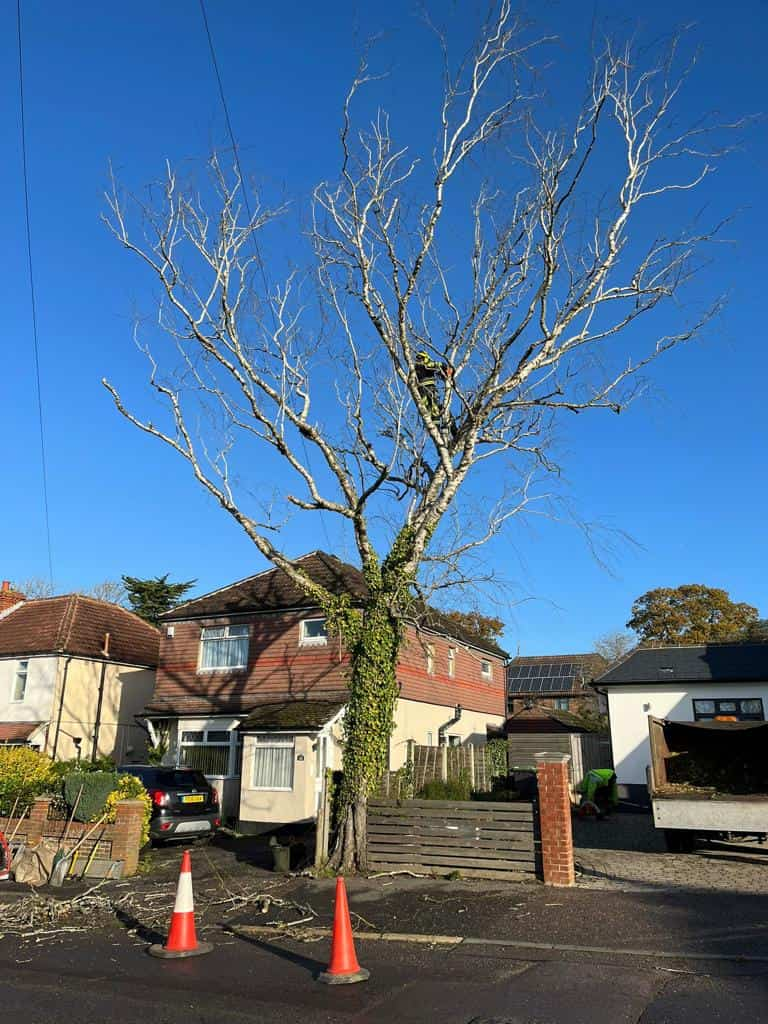Tree felling is often seen as a last resort, but there are certain situations where removing a tree is not only necessary but crucial to the well-being of surrounding trees and the overall health of your garden. At LM Tree Surgery Portsmouth, we understand the importance of trees and their contribution to the environment, but we also recognise that tree felling is sometimes the best solution to protect other nearby trees, property, and even people.
In this article, we’ll explore the key reasons why tree felling might be necessary to protect nearby trees and why it should always be carried out by experienced professionals.
1. Preventing Disease Spread
One of the most common reasons for tree felling is to prevent the spread of disease to other trees. Certain diseases, such as root rot, fungal infections, or bacterial cankers, can spread quickly between trees, especially if they are closely located. If one tree becomes infected, removing it can help contain the disease and protect the rest of the trees in the area.
Key points on disease prevention through tree felling:
- Infected trees can serve as a breeding ground for pests or fungi, spreading to neighbouring trees.
- Removing the affected tree reduces the risk of disease transmission to other healthy trees nearby.
- Fungal spores can travel long distances, especially in the wind, so prompt action is necessary.
Tree felling, in this case, becomes an essential part of safeguarding the health of your entire garden or property.
2. Overcrowding and Competition for Resources
In urban gardens or densely wooded areas, trees can become overcrowded, competing for sunlight, water, and nutrients. When this happens, some trees may grow weak, stunted, or unhealthy. In some cases, the best way to ensure the health of the remaining trees is to remove the one that is causing the competition.
Benefits of felling a tree in an overcrowded area:
- Promotes healthy growth for surrounding trees by giving them more space, light, and resources.
- Allows for better air circulation which reduces the risk of fungal infections and promotes overall tree vitality.
- Prevents trees from becoming root-bound, which could otherwise lead to premature decline.
If a tree is inhibiting the growth of healthier or more valuable trees nearby, tree felling may be necessary to allow the others to flourish.
3. Preventing Structural Damage to Nearby Trees
Sometimes, the structure of a tree may become dangerous to the nearby trees, especially when branches or roots start encroaching on others. A tree that is too close to others may also cause physical damage to the roots of its neighbours, especially if the tree is growing at an unusual angle or is leaning.
Signs that tree felling is necessary to prevent structural damage:
- Overhanging branches that are damaging or putting pressure on nearby trees.
- Leaning trees that may fall and cause significant damage to surrounding vegetation.
- Root damage that can starve nearby trees of vital nutrients and water.
In these cases, removing the problematic tree can prevent long-term harm to the rest of your garden or even your property.
4. Protecting Property and People
While not always a direct issue for nearby trees, sometimes tree felling is required to protect property or people from the risks associated with unstable trees. If a tree becomes weak due to disease, storm damage, or old age, it may pose a threat to both its surroundings and the trees nearby.
Tree felling for safety:
- Dangerous trees can collapse or drop branches unexpectedly, causing injury or damage to property.
- Trees near power lines may need to be removed to prevent accidental contact, which could be dangerous for both trees and surrounding structures.
- Fallen trees can cause damage to nearby trees and infrastructure if not managed correctly.
If you have a tree that poses a safety risk, felling may be the most effective solution to protect both people and the surrounding trees.
5. Allowing for Landscape Design and Aesthetic Improvements
In some cases, tree felling is part of a planned landscaping design. Whether you’re looking to improve the overall aesthetic of your garden, increase the space for a new feature, or create a more open environment, removing a tree may be necessary to improve the layout and appearance of the area.
Landscape improvements through tree felling:
- Opening up the space for new plants, features, or structures that can improve the overall look of your garden.
- Enhancing the view or creating space for more sunlight to flood into your home or garden.
- Achieving a balanced landscape by removing trees that disrupt the visual flow of your outdoor space.
When done strategically, tree felling can significantly enhance the functionality and beauty of your garden or landscape.
Conclusion
Tree felling is a serious decision, and while it may seem like a drastic measure, there are times when it is necessary to protect other trees, the surrounding environment, and even your property. Whether it’s to prevent disease from spreading, manage overcrowding, protect structures, or enhance the aesthetic value of your garden, tree felling, when carried out by a qualified arborist, can be the best course of action.
If you’re facing any of these issues in your garden or on your property in Portsmouth, Hampshire, don’t hesitate to contact LM Tree Surgery Portsmouth. Our professional team has the expertise to assess your trees and provide the best solution, ensuring the health and safety of your landscape. Let us help you protect your trees and enhance the beauty of your outdoor space. Reach out today for a consultation.
Call us on: 023 8235 3287
Click here to find out more about LM Tree Surgery Portsmouth
Click here to complete our contact form and see how we can help with your trees needs.

